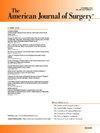腹腔热化疗(HIPEC)治疗胃癌伴腹膜转移-欧洲GASTRODATA和美国国家癌症数据库联合分析
IF 2.7
3区 医学
Q1 SURGERY
引用次数: 0
摘要
姑息性化疗是目前晚期胃癌(GC)伴腹膜转移(PM)患者的标准治疗方案,而胃切除术联合细胞减缩手术和HIPEC的作用尚不清楚。目前的研究旨在评估胃癌合并PM患者接受胃切除术和腹腔热化疗(HIPEC)的治疗结果,使用多国癌症登记处。方法分析(2012-2022)包括来自欧洲GASTRODATA登记处(欧盟队列)和美国国家癌症数据库(NCDB,美国队列)的IV期GC PM胃切除术和HIPEC患者。研究结果为教科书肿瘤学预后(TOO)评估和总生存期(OS)。193例患者中,49.7%来自欧盟队列,50.3%来自美国队列。欧盟队列的pT4肿瘤(欧盟:50%,美国:40.2%)、转移性淋巴结(欧盟:68.8%,美国:54.6%)和≥16个淋巴结(欧盟:91.7%,美国:68%)的发生率显著较高。术后,EU组住院时间较长(EU: 53.1% vs 22.2%, p <;0.001), 30天再入院率(欧盟:14.6% vs美国:7.2%,p = 0.11)和90天死亡率(欧盟:4.2% vs美国:9.3%,p = 0.25)无显著差异。在欧盟和美国的队列中,TOO的发生率分别为30.2%和32%。在美国队列中,与非TOO患者相比,TOO患者的1- (86.7% vs. 57.4%)、3- (55.8% vs. 29.7%)和5年OS (50.2% vs. 29.7%)生存率提高(p = 0.0025)。结论在接受胃切除术和HIPEC的胃癌和PM患者中,TOO的实现与术后并发症风险降低(欧盟队列)和长期生存率提高(美国队列)相关。本文章由计算机程序翻译,如有差异,请以英文原文为准。
Hyperthermic intraperitoneal chemotherapy (HIPEC) for gastric cancer with peritoneal metastasis - Joint analysis of European GASTRODATA and American national cancer database
Introduction
Palliative chemotherapy is the current standard among advanced gastric cancer (GC) patients with peritoneal metastasis (PM), while the role of gastrectomy with cytoreductive surgery and HIPEC remains unclear. The current study aimed to assess treatment outcomes among GC patients with PM undergoing gastrectomy and hyperthermic intraperitoneal chemotherapy (HIPEC) using multinational cancer registries.
Methods
The analysis (2012–2022) included stage IV GC patients with PM undergoing gastrectomy and HIPEC from the European GASTRODATA Registry (EU cohort) and the American National Cancer Database (NCDB, U.S. cohort). The study outcomes were textbook oncological outcome (TOO) assessment and overall survival (OS).
Results
Among 193 patients, 49.7 % were from the EU cohort and 50.3 % from the U.S. cohort. EU cohort had significantly higher rates of pT4 tumors (EU: 50 % vs U.S.: 40.2 %), metastatic lymph nodes (EU: 68.8 % vs U.S.: 54.6 %), and ≥16 lymph nodes evaluated (EU: 91.7 % vs U.S.: 68 %). Postoperatively, the EU cohort had longer hospital stay (EU: 53.1 % vs 22.2 %, p < 0.001), with no significant differences in 30-day readmission (EU: 14.6 % vs U.S: 7.2 %, p = 0.11) and 90-day mortality (EU: 4.2 % vs U.S.: 9.3 %, p = 0.25). TOO rates were 30.2 % and 32 % for EU and U.S. cohorts, respectively. Within the U.S. cohort, TOO achievement was associated with improved 1- (86.7 % vs. 57.4 %), 3- (55.8 % vs. 29.7 %), and 5-year OS (50.2 % vs. 29.7 %) (p = 0.0025) survival compared with non-TOO.
Conclusions
Among patients with GC and PM undergoing gastrectomy and HIPEC, achievement of TOO was associated with decreased risk of postoperative complications (EU cohort) and improved long-term survival (U.S. cohort).
求助全文
通过发布文献求助,成功后即可免费获取论文全文。
去求助
来源期刊
CiteScore
5.00
自引率
6.70%
发文量
570
审稿时长
56 days
期刊介绍:
The American Journal of Surgery® is a peer-reviewed journal designed for the general surgeon who performs abdominal, cancer, vascular, head and neck, breast, colorectal, and other forms of surgery. AJS is the official journal of 7 major surgical societies* and publishes their official papers as well as independently submitted clinical studies, editorials, reviews, brief reports, correspondence and book reviews.

 求助内容:
求助内容: 应助结果提醒方式:
应助结果提醒方式:


